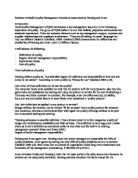Evaluate critically Quality Management theories as expounded by Deming and Juran.
Evaluate critically Quality Management theories as expounded by Deming and Juran.
Introduction
Total Quality Management (TQM) has become a key management issue due to the increasing importance of quality. The gurus of TQM define it to suit their beliefs, prejudices and business and academic experiences. There are common elements such as top management support, customer and supplier relationships and employee involvement. "They are all talking the same `language' but they use different dialects" (Oakland, 1989). Oakland (2003) demonstrates the differences and similarities of Deming and Juran under 12 different factors.
I will address the following:
· Definitions of quality.
· Degree of senior management responsibility.
· Improvement basis.
· Cost of quality.
Their definitions of quality
Deming defines quality as, "a predictable degree of uniformity and dependability at low cost and suited to the market". According to Juran quality is, "fitness for use" (Oakland 2003 p.18).
Can either of these definitions on its own be quality?
The consumer needs to be satisfied not only that the product is fit for its purpose but also that s/he gains value and satisfaction by owning and using the product or service for the cost of obtaining it. This may vary from customer to customer. For example, a car that offers security, durability, luxury or any such added feature is more likely to be considered a 'quality product'.
Can their definitions be applied to any product or service?
Budget airlines, for instance, can be termed "fir for purpose" and a quality product for someone cost conscious, whereas a conventional flyer will regard the quality of budget airlines to be poor due to squashed seating and catering.
"Deming advocates no specific definition. This is broken down in to four categories: quality of design and conformance, availability and field services. This definition is very vague and unclear where as Juran's definition as mentioned earlier is very clear and fits well in to existing management systems" (Dean and Evans 2001).
Degree of senior management responsibility
Deming and Juran agree here. Deming states that senior managers are responsible for 94% of quality problems. Juran agrees by stating that only 20% of quality problems are due to workers (Oakland 2003 p.8). Both stress that to succeed an organisation needs long-term commitment and innovation of top management (Landesburg. P Nov/Dec 99 p.59-61).
Introduction
Total Quality Management (TQM) has become a key management issue due to the increasing importance of quality. The gurus of TQM define it to suit their beliefs, prejudices and business and academic experiences. There are common elements such as top management support, customer and supplier relationships and employee involvement. "They are all talking the same `language' but they use different dialects" (Oakland, 1989). Oakland (2003) demonstrates the differences and similarities of Deming and Juran under 12 different factors.
I will address the following:
· Definitions of quality.
· Degree of senior management responsibility.
· Improvement basis.
· Cost of quality.
Their definitions of quality
Deming defines quality as, "a predictable degree of uniformity and dependability at low cost and suited to the market". According to Juran quality is, "fitness for use" (Oakland 2003 p.18).
Can either of these definitions on its own be quality?
The consumer needs to be satisfied not only that the product is fit for its purpose but also that s/he gains value and satisfaction by owning and using the product or service for the cost of obtaining it. This may vary from customer to customer. For example, a car that offers security, durability, luxury or any such added feature is more likely to be considered a 'quality product'.
Can their definitions be applied to any product or service?
Budget airlines, for instance, can be termed "fir for purpose" and a quality product for someone cost conscious, whereas a conventional flyer will regard the quality of budget airlines to be poor due to squashed seating and catering.
"Deming advocates no specific definition. This is broken down in to four categories: quality of design and conformance, availability and field services. This definition is very vague and unclear where as Juran's definition as mentioned earlier is very clear and fits well in to existing management systems" (Dean and Evans 2001).
Degree of senior management responsibility
Deming and Juran agree here. Deming states that senior managers are responsible for 94% of quality problems. Juran agrees by stating that only 20% of quality problems are due to workers (Oakland 2003 p.8). Both stress that to succeed an organisation needs long-term commitment and innovation of top management (Landesburg. P Nov/Dec 99 p.59-61).







